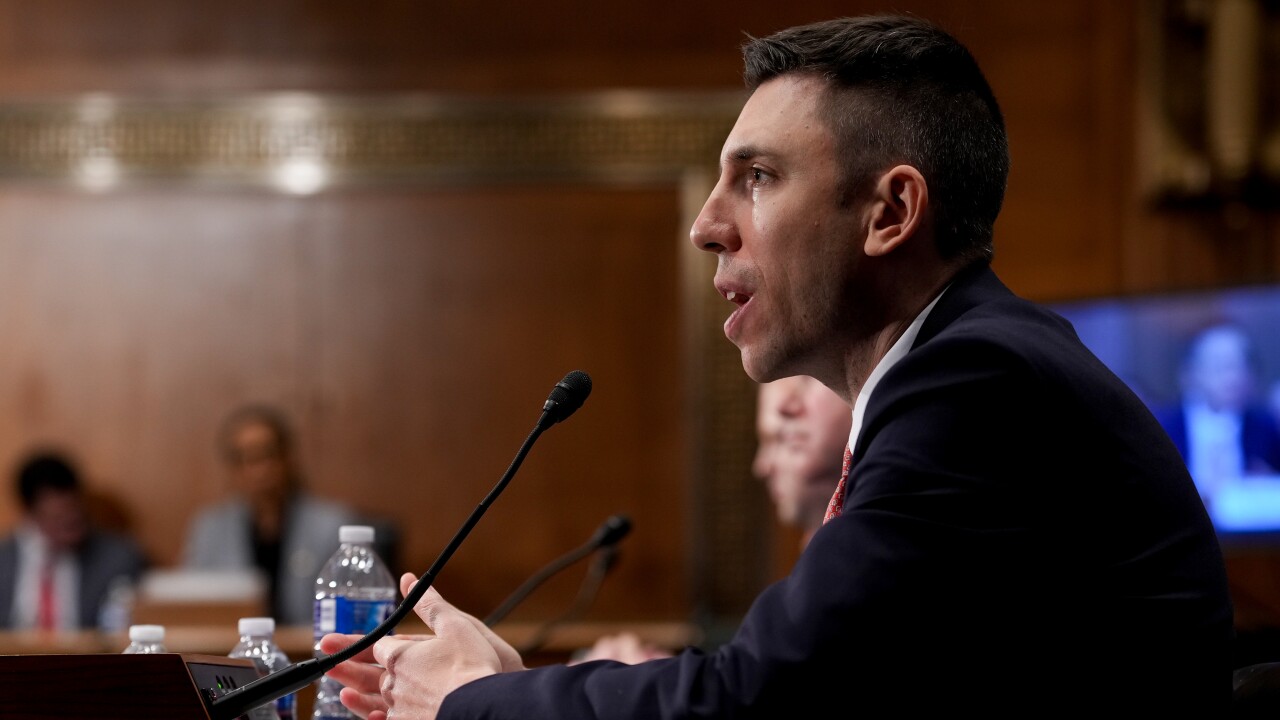- Key insight: Acting Federal Deposit Insurance Corp. Chair Travis Hill expects the agency to publish its first rules implementing the recently passed stablecoin bill by the end of the year.
- Expert quote: "The most immediate-term proposal we're going to issue is one that sets up an application process, which is something that's required under the statute." — Acting FDIC Chair Travis Hill
- Forward look: Hill also said the FDIC is working in tandem with other banking regulators to develop prudential standards for stablecoin issuers, including capital and reserve requirements and risk-management rules.
PHILADELPHIA — Federal Deposit Insurance Corp. Acting Chair Travis Hill said the agency is moving quickly to implement the recently passed GENIUS Act and expects the first proposed rules, related to the process of applying to become a stablecoin issuer, to be published by the end of the year.
Speaking at the Federal Reserve Bank of Philadelphia's Fintech Conference Thursday, Hill said the agency is moving with all deliberate speed to implement the recently passed stablecoin legislation.
Hill said it remains unclear how significant the FDIC's role in the stablecoin regulatory regime will be because the FDIC is tasked with supervising only those stablecoins issued by FDIC-supervised entities.
"We, as the FDIC, our primary role under the GENIUS Act is supervising FDIC-supervised institutions that set up subsidiaries to issue stablecoins. It's too early to say what that universe is going to be — whether that's going to be a large universe or a small universe — but we are still required under the statute to issue rules for that potential universe," HIll said. "The most immediate-term proposal we're going to issue is one that sets up an application process, which is something that's required under the statute. That's something that I would expect us to issue before the end of the year, that initial proposal."
Hill added that the agency is also working with fellow banking regulators to develop prudential standards for potential stablecoin issuers, which would detail important requirements like capital and reserve rules and risk-management capacities.
"We also are working on prudential standards for stablecoin issuers that we would supervise," Hill added. "So that would include things like capital requirements, reserve requirements, interest-rate-risk management, things like that — all of which are required under the statute. That's something we're coordinating with the other agencies as well."
Hill said the FDIC is tasked under the law with determining what limitations there should be on the types of reserves that stablecoin issuers use to back their offerings and to police misrepresentation of deposit insurance. The agency also sits on the newly established interagency Stablecoin Certification and Review Committee, which reviews applications from "large nonfinancial institutions" seeking to issue stablecoins and to review overseas and state-level stablecoin regimes for compliance with federal standards.
The passage of the GENIUS Act, which President Trump signed into law in July, has put the banking industry in a defensive posture, with many banks and representative trade groups complaining that the law's weak prohibition on interest for stablecoin holders could lead to a drain of deposits from the banking sector.
Hill did not comment on stablecoin interest directly, but said he believes that, while the emergence of stablecoins could result in deposit flight at individual banks, those deposits will most likely migrate elsewhere within the banking sector.
"I think when it comes to the disintermediation question, at a macro level, if a depositor takes its funds out of a community bank and puts it into a stablecoin, obviously that's going to be very disruptive to the community bank regardless of where those funds go," Hill said. "But I think it's worth, as we think about the macro impacts, to appreciate that, a lot of times, those funds are still going to stay in the aggregate banking sector, even if it moves around and potentially is converted from one kind of deposit to another kind of deposit."
Hill did point to what he called one significant challenge:the possibility that deposits, over the course of their migration around the banking sector, find their way into another bank's Federal Reserve account. Banks' accounts with the Fed earn interest from the central bank but are not relied upon as funding sources for lending activity the way traditional core deposits are.
"There are, obviously, exceptions to that — a big exception to that is if somewhere along the chain, someone else has access to the Federal Reserve's balance sheet, in which case, instead of it being a deposit at a bank, it's on the balance sheet of the Fed," HIll continued. "I think these are just complicated concepts for people to think through, but, again, in terms of the fundamental question, that's something we're going to be monitoring very closely."







